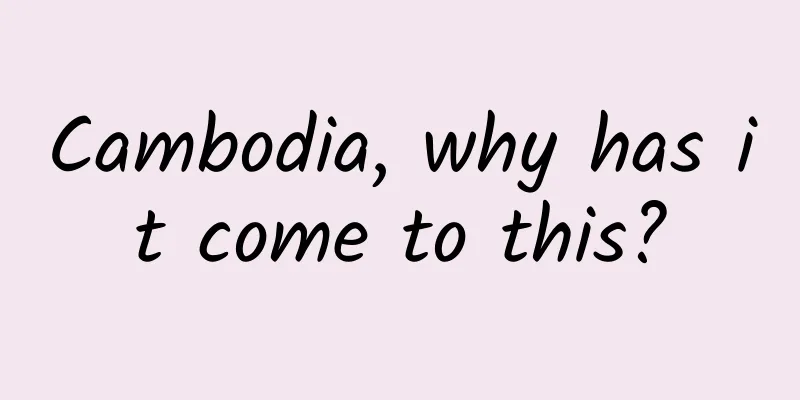Cambodia, why has it come to this?

|
here it is Cambodia The daunting media coverage One of the bases for human trafficking and online fraud (From Cambodia-China Times) ▼ “Telecom fraud and human trafficking in Cambodia… It has had a serious impact on economic and social development.” In the eyes of historians, site of one of the massacres (From American historian Kenton Kramer) ▼ 'On a par with Nazi Germany' (The Choeung Ek Genocide Memorial in Phnom Penh, Cambodia, photographer @肖文凯) ▼ International journalists A place abandoned by modern civilization (From a 2012 book by American international journalist Joe Brinkley) ▼ "More than three quarters of the population still lives much the same as they did a thousand years ago" (Please watch horizontally, Cambodian river dwellings, photographer @梁杰) ▼ However, thousands of years ago This is where the earliest country in Southeast Asia was born. The dynasty that emerged dominated Southeast Asia for five centuries Angkor Wat, the largest temple complex in the world It is so beautiful and magnificent that even French scholars describe it as (From the 19th century French naturalist Henri Mouhot) ▼ "More magnificent than anything left to us from Greece or Rome" (Angkor Wat under the rising sun, picture source: Visual China) ▼ So brilliant, so decadent One can't help but ask What exactly happened in Cambodia? 01 The most fertile land As a Southeast Asian country Cambodia opened with a "king bomb" First, we are talking about Southeast Asia It is actually composed of continents and islands. The continental part is the largest Because it is located in southern China, it is called the "Indochina Peninsula" Cambodia is on top of it (Illustration of countries in the Indochina Peninsula, map by @Gao Liqian/Planetary Research Institute) ▼ This is a vibrant land. Many mountain ranges stretch out from north to south. Several rivers cut through the mountains and valleys, rushing southward Among them, the Lancang River, which originated in China, flows abroad Renamed "Mekong River" It runs across the entire peninsula With a length of 2711 km, The longest river in Southeast Asia (The length of the Mekong River above refers only to the length outside the country. Please watch it in horizontal mode. The Mekong River in Cambodia, photographer @陈剑峰) ▼ The Mekong River flows southwards into Cambodia It is surrounded by mountains on the north, east and west. Like a big basin The mountains in the southwest are the most rugged The highest peak, Aola Peak, is 1,813 meters above sea level. The highest point in the country (Farmers living at the foot of the Cardamom Mountains in Cambodia, named after the abundant herb cardamom, picture source @Visual China) ▼ The central part of the basin is the largest freshwater lake in Southeast Asia. The vast plain shaped by the Tonle Sap Lake Further south, there is the alluvial delta of the Mekong River. Low-lying terrain and fertile land This area is surrounded by mountains Fertile soil formed by the central lakes and rivers The earliest Cambodia (Map of Cambodia's topography, drawn by Gao Liqian/Planet Research Institute) ▼ There is abundant water and the climate is hot and humid. Very easy to grow food Tonle Sap Lake is like a natural "regulator" Rainy season from May to October Mekong River water flows back into lake Expand the lake to 10,000 square kilometers Nourishes a large number of fish and shrimp It still provides 60% of the protein for Cambodians. (Rainfall at sunset on Tonle Sap Lake, image source: @Visual China) ▼ During the dry season, lake water flows back into the Mekong River The lake surface has shrunk dramatically, exposing large areas of muddy land. It is the fertile land for growing food. (Dragon boat racing during Cambodia’s Water Festival. The Water Festival is an important traditional festival in Cambodia. Every November, Cambodia enters the dry season, and the water from the Tonle Sap Lake feeds the Mekong River. It is the season for fishing and rice harvesting. Image source: Visual China) ▼ Cambodians are so lucky They own this "God-given granary" No need to fight We have been able to rely on nature for survival since a long time ago No one knows when Cambodia's first inhabitants appeared. Where are you from? Archaeological discoveries only tell us As early as 4200 BC They already know how to make pottery (Children who have been dealing with boats since childhood on Tonle Sap Lake. Prehistoric Cambodians and today's Cambodians are very similar in physique. Photographer @陆雨春) ▼ Many customs of prehistoric Cambodians continue to this day They live in stilt houses above the water. They learned how to fish, raise cattle and grow rice very early on. Worship of earth and water gods This is the premise for everything they have. (Stilt houses on Tonle Sap Lake in Cambodia, photographer @平老虎) ▼ There's danger around. Cambodia has a hot and humid climate and is often home to poisonous snakes. Snake venom is strong, and snakes have strong reproductive capacity It was a powerful creature in people's minds at that time. People fear it and worship it From this evolved into Cambodians Auspicious signs that are still believed in today (Sculpture of the snake god Naga in Angkor Wat, Cambodia, image source @Visual China) ▼ Cambodia was still very primitive at this time. People don't wear clothes, have no writing, laws, or country All this was started by visitors from India Around 50 AD An Indian adventurer crosses the sea Arrival in Cambodia After defeating the local natives who attempted to kidnap him Married the chief's daughter and inherited the chief's kingdom This is the origin of Cambodia, which is widely circulated. More Indian merchants arrived later Through religion and marriage The more advanced Indian culture was quickly accepted by the locals Indian Sanskrit becomes the official language of Cambodia (There are several versions of this legend, with slightly different details. The picture below is a Sanskrit stone carving of the Cardamom Temple, photographer @老J) ▼ People wear clothing with distinctive Indian characteristics Eat with a spoon and right hand Carrying goods with the head Behavior habits are very similar to those in India (Vendors in Cambodia, photographer @季海峰) ▼ Religion brought by Indians Brahmanism It soon became the mainstream religion in Cambodia. It strictly divides people into four classes The barriers between classes are clear and insurmountable The incarnation of Lord Shiva, one of the main gods of Brahmanism Linga statues are widely worshipped by people (The Cambodian Linga statue is a male genitalia carved out of stone, which is a manifestation of Shiva's "power of regeneration". The picture below is a stone sculpture in Litchi Mountain National Park. Map by @冯艺卓/星球研究院, picture source @视觉中国) ▼ The sacred mountain "Sumeru" in Brahmanism evolved into people's worship of mountains They built their palaces on the mountains The leader calls himself "King of the Mountain" and is the incarnation of a god. In ancient Khmer, mountains are called "bnam". The Chinese envoys then used the chief's title The country was recorded as the Mountain Kingdom - "Funan" (Cultural relics unearthed from the E'e site in Vietnam today. Many scholars believe that this was the seaport of the Funan Kingdom. Image source: @Visual China) ▼ The kingdom's center is on the lower Mekong River The water network here is dense and prone to flooding The royal city then built a drainage and irrigation system that extended in all directions. Agriculture was secured and the population gradually prospered Funan is the earliest country in Southeast Asia In the first six centuries of the Christian era Its sphere of influence covers the entire Indochina Peninsula Not only did he receive envoys from Sun Quan of the Three Kingdoms, It also established diplomatic relations with the Indian dynasty This powerful country later fell into civil strife due to a dispute over the throne The northern vassal state of Zhenla took the opportunity to invade 8th century Foreigners from nearby Java Island are eyeing They plundered and attacked the royal city. The Cambodian king was even captured Submission to Java The Mountain Kingdom has been torn apart But it has a good foundation A golden age has arrived The overture is ready 02 The most powerful era 802 AD It has been nearly 50 years since the Anshi Rebellion in the Tang Dynasty A great Chinese empire is coming to an end In Cambodia, a powerful kingdom is emerging This year A Cambodian royal captive in Java Back to the homeland He put down the turmoil in one fell swoop Conquering the Divided Land Freeing Cambodia from Java's shadow This time, the new king will take the capital Migrate north to the north of Tonle Sap Lake Today's Angkor area Here there are high mountains for him to build temples There are also abundant fish and shrimp in the large lakes and rice in the plains. Sufficient to support a large population For hundreds of years thereafter, the capital was located near Angkor. Later generations called this period the Angkor Dynasty (Kulun Mountain, one of the sacred mountains of Cambodia in the north of Angkor, where the new king held a sacrificial ceremony, marking the beginning of the Angkor Dynasty. Image source: @Visual China) ▼ To ensure that rice can be harvested regardless of rain or drought Cambodia's irrigation system upgraded again The dynasty built many large reservoirs to store rainwater The largest reservoir The capacity has reached 53 million cubic meters Agriculture has developed rapidly In some areas, rice can be harvested three or four times a year. (Sibalai Lake is the largest reservoir in the Angkor period, map by @冯艺卓/Planet Research Institute, picture source @Visual China) ▼ Food is plentiful and population is growing Angkor's national power prospered The kings then embarked on another major project Building statues and temples The style and tradition of Cambodian architecture was formed at this time That was the reign of the third king of Angkor He ordered the construction of six brick and stone towers The tower houses statues of his parents and ancestors. In order to allow the souls of our ancestors to live forever in the "Immortal Body" This group of buildings was built in the 9th century AD Also known as Preah Ko Temple Although small in scale The carvings are extremely exquisite, far surpassing any previous buildings It started the tradition of building temples within moats and city walls This is the Khmer architectural style that has continued since then. (Shengniu Temple, picture source @Visual China) ▼ Not only that, the king also built The first pyramid-like temple in Angkor Bakong Temple The temple is built on the foundations of the towers It is the "Sumeru" where the gods in Brahmanism live. Also known as "Temple Mountain" The tradition of building temple hills has continued for hundreds of years since the establishment of Angkor. Unlike the reservoir or the Holy Bull Temple The temple hill was reserved for the king and became his tomb after his death (Bakong Temple, photographer @Lu Yuchun) ▼ This is the earliest major building complex of the Angkor Dynasty. The erection of statues and the construction of temples became the characteristics of the Angkor Dynasty. They are diverse in form and have distinct characteristics in Preah Vihear Temple , the tallest mountaintop temple in Cambodia Standing on the edge of the cliff at the Cambodia-Thailand border Overlooking the Kingdom's Changes (Preah Vihear Temple, 525 meters above sea level, its ownership has repeatedly caused fierce disputes between Thailand and Cambodia, picture source @Visual China) ▼ Prasat Thom, outside Angkor It has seven floors and is 35 meters high. The king's power is reflected in his ambition to reach the sky (Prasathorn Temple, photographer @朱智勇) ▼ Queen's Palace , known as the "Gem of Angkor Art" Made of pink sandstone It stands out among the gray and black Cambodian buildings. Famous for its large number of fine female reliefs (Queen's Palace, Photographer @平老虎) ▼ 11th to first half of the 12th century Angkor Dynasty reaches its peak Warlike King Suryavarman II Led the army to invade Vietnam and attack Thailand Greatly expanded the kingdom's territory The buildings built by such a powerful lord are naturally more magnificent He recruited a large number of laborers A group of magnificent temples were built on the south side of the royal capital. This is the famous Angkor Wat (Aerial photography of Angkor Wat, you can clearly see the entire layout, picture source @Visual China) ▼ Angkor Wat covers an area of nearly 163 hectares Including temples, mausoleums, and observatories In the center is still a tall pyramid-shaped temple mountain. There are five pagodas on the temple hill. The tallest one is 65 meters high. The outermost part is a moat about 200 meters wide. Magnificent architecture and exquisite reliefs It is the largest temple complex in the world today. It may also be the most beautiful relic of the Angkor Dynasty. (Angkor Wat, picture source @Visual China) ▼ However, the shadow beneath the glory has already appeared Years of war and construction consumed a lot of national strength. Not only is there rebellion at home, but neighboring countries are also ready to make a move There is an ancient country called Champa to the east of Cambodia It is much smaller than Cambodia. Once defeated by the Angkor Dynasty But this time it took advantage of the civil unrest in Angkor Conquer the Mekong Delta and sail upstream In 1177 AD, they captured the capital Angkor. The occupation of Cambodia lasted four years (Please watch horizontally, the My Son Sanctuary, a Champa ruins located in present-day Vietnam, image source: @Visual China) ▼ Destiny did not abandon the Angkor Dynasty At this moment, another leader appeared to save the crisis. Jayavarman VII "Vaman" means "protector" in Sanskrit. He indeed played this role. He organized a well-trained army to fight back Not only did he recover Angkor, he also occupied Champa territory The king actively expanded his territory Created the largest territory in Cambodia's history It borders the South China Sea to the east, Myanmar to the west, and the Malay Peninsula to the south. Even covers southern Vietnam, Thailand and most of Laos It was the most powerful country in Southeast Asia at that time. (Sketch of the territory of the Angkor Dynasty, drawn by @Gao Liqian/Planetary Research Institute) ▼ The looted Angkor capital is in ruins To avoid being invaded again Jayavarman VII was determined to rebuild an impregnable city This is the famous ruins we can still see today Angkor Thom Angkor Thom is a neat square city. There are three kilometers of thick city walls on each side of the city. The height is 8 meters There is a moat about 100 meters wide outside the city wall. Enough to scare away any enemy (The gate of Angkor Thom, photographer @王心超) ▼ Five stone causeways span the moat Enter the city through five tall gates The intersection is the center of the kingdom Bayon Temple (Bayon Temple, photographer @潘伟光) ▼ This is a huge group of temples second only to Angkor Wat. It consists of a pyramid-shaped temple and 54 four-sided towers. Each side of the four-sided pagoda is carved with a huge Buddha face The Buddha has a peaceful expression with a slight smile Its mystery makes people explore again and again This is the world famous “Khmer Smile” (The smile of Cambodia, photographer @胡子杰森) ▼ The picture of a magnificent dynasty has now fully emerged. Its capital city is impregnable Its water conservancy facilities are precise and effective It has a vast territory and a large population. All enemies who dare to challenge you will surrender However, the shadow did not disappear It is getting bigger and bigger No powerful country can withstand such frequent military construction. Taxes and labor service on civilians increased The king's divine right is no longer strong People began to doubt the Brahmanism they once believed in. Is the king really the incarnation of the gods? Can it really protect the people? This crisis of faith is getting worse The sudden decades of drought Another heavy blow to this agricultural kingdom Water conservancy projects that ensure grain production have lost their function and lack maintenance Khmer people began to experience unpredictable rainfall If prosperity needs to be built gradually Defeat will come like an avalanche The Thai invaded the north of the Angkor Empire Occupied a large area of Cambodia They established in Chinese history books The kingdom known as Siam The former Cambodian city of Sukhothai became the capital of the Thai people (The reasons for the decline of the Angkor Dynasty are still under debate. This article refers to some mainstream views in the academic community. The picture below shows the ruins of the ancient city of Sukhothai. Photographer: Xue Fei) ▼ The Thais continued to attack Angkor The "indestructible" royal city failed to stop the enemy Conquered twice then Faith changes, climate change, peasant uprisings, foreign invasions Just like sparks continue to fall on this huge empire Finally, a huge fire broke out. Burn its prosperity 1432 AD The reigning king fled to Siam Abandon Angkor Moved the capital to the south where Funan Dynasty once stood Capital of Phnom Penh The Angkor Dynasty ended The darkness caused by the dark clouds that hover over Cambodia Just the beginning 03 The heaviest cloud Back to Cambodia by the Sea Developing maritime trade by leveraging geographical advantages But in the three centuries that followed It is constantly fighting for royal power. The threat from powerful neighbors has never been eliminated Siam repeatedly interfered in Cambodia's internal affairs Even sent troops to support the king candidate For the first time in Cambodian history, a puppet king controlled by Siam appeared Cambodia has not been without struggle King Anzan, who reigned in 1516 Once revived Cambodia He led his army to defeat the invading Siamese at the riverside of Angkor A village near the battlefield was named "Siem Reap" Meaning "Conquered Siamese" Later it became a famous tourist city in Cambodia (Please watch in horizontal mode, Siem Reap landscape, image source: @Visual China) ▼ However, this accomplished King Anzan But was quickly overthrown by troops from eastern Cambodia These regions are backed by a new force Cambodia's other neighbor Vietnam This is tantamount to seeking the skin of a tiger Vietnam is a small country with a dense population Long coveted Cambodia's fertile land From 1699 to 1775, more than 70 years Vietnam encroachs Completely occupied Cambodia's fertile Mekong Delta This is a fatal blow to Cambodia. The Mekong Delta is also an outlet to the sea. The Vietnamese strangled Cambodia's sea trade and established a new trade center This is Ho Chi Minh City, the largest city in Vietnam today. Cambodia quickly became impoverished after losing its trade source For the next 200 years, they were trapped inland and isolated from the outside world. (Ho Chi Minh City, dating back hundreds of years, was still Cambodian territory, picture source @Visual China) ▼ Cambodia in the 18th and 19th centuries is a History of continuous enslavement and invasion by Thailand and Vietnam The most typical event is In 1817, the Vietnamese conscripted tens of thousands of Cambodians to dig A canal leading to the Gulf of Siam Thousands of Khmer died during this period Yongji Canal Became a symbol of Vietnamese enslavement of the Khmer people (Vietnam Yongji Canal, picture source @Visual China) ▼ Mid-19th century Thailand and Vietnam's competition for Cambodia intensifies At this time, a new entrant appeared France French missionaries came to Cambodia very early 1850s The King of Cambodia wanted to avoid being completely devoured by Thailand and Vietnam. Choose to ask France for help In 1863, Cambodia signed a treaty with France. Trading logging and mining rights for conservation So, not a single shot was fired. French colonial rule in Cambodia begins The French began to build colonies The capital city of Phnom Penh is close to the sea and rivers. Suitable for being built into a commercial center French blood is gradually being injected into this Cambodian city A large number of French-style buildings appear in the streets and alleys (French-style buildings on the streets of Phnom Penh, photographer @艾斌) ▼ French baguette has become the most common breakfast for Phnom Penh residents (Bags sold in baskets at Siem Reap Market, photographer @陆雨春) ▼ They even built Cambodia's first high school in Phnom Penh Send dozens of talented students to study in Paris I hope they will serve the colonial government after returning home. One of the students, Pol Pot , lived up to expectations. As expected, a huge wave was set off in Cambodia. However, it will still take several decades for him to appear. France is no benevolent protector They gradually took control of Cambodia's administration, judiciary, and finance. They even appointed and dismissed kings at will. Pro-Franco people came to power, and those with independence tendencies were removed In 1941, the reigning King Monivong died The French chose a man named Norodom Sihanouk 's royal family inherits the throne He is only 21 years old and has no independent tendencies A good candidate for control (Sihanouk around 1946, image source @wikimedia commons) ▼ However, France got it wrong this time. This is not a weak king. During Sihanouk's reign Maneuvering between Japan, the United States and other forces Fight for Cambodia's independence Finally, on November 9, 1953 Under pressure from the complex international situation and various parties Cambodia and France in front of the Royal Palace in Phnom Penh A grand handover ceremony was held France's nearly 90-year colonial rule in Cambodia came to an end November 9th is Cambodia's National Day (Cambodia Independence Monument, photographer @艾斌) ▼ Cambodia's successful independence brought Sihanouk's prestige to its peak The people love him very much and call him a "national hero" He relied on his personal prestige Cambodia has gained 15 years of political stability During this period, he relied on his declaration to maintain independence and resist imperialism. Winning China’s Friendship (From February 13 to 21, 1956, Prince Sihanouk led a Cambodian national delegation to visit China. Image source: @wikimedia commons) ▼ Factories built with Chinese assistance laid the foundation for Cambodia's industry Cambodia is gradually becoming more educated and its economy is booming. That was the "golden age" that many people remembered many years later. A bright future for Cambodia seems to lie ahead However, the thousands of cheering Khmer people did not expect This hope, this happiness, is so short-lived (Cambodia Zhuoleiding Cement Co., Ltd. was one of the early factories built with Chinese aid. Image source: @Zhuoleiding Cement Co., Ltd. official website) ▼ This period was also the Cold War period of confrontation between the United States and the Soviet Union. American forces gradually invade Cambodia To oppose US interference In 1965, Sihanouk severed diplomatic ties with the United States and refused U.S. foreign aid. This inevitably affected the domestic economy. Sihanouk's enemies begin to extend their tentacles In 1970, when Sihanouk was on a foreign visit Pro-American domestic forces launched a coup to oust Sihanouk Sihanouk had nowhere to go, so he went into exile in China. For the people of Cambodia Like a bolt from the blue How could the god-like Sihanouk be overthrown? Revolts broke out in many provinces Sihanouk took the opportunity to ally with the Communist Party of Cambodia Joint opposition to the new government This was the organization that was later translated as the Khmer Rouge. Pol Pot, the student studying in France mentioned above One of the leaders of the Khmer Rouge Western ideas had a great impact on him, who was born in a feudal country. He questioned the king's existence and joined the revolution (Articles published by Pol Pot when he was a student, illustration by @冯艺卓/Planetary Research Institute) ▼ In the next few years War between the pro-American government and the Khmer Rouge continues The pro-US government’s military is poorly trained and plagued by corruption The Khmer Rouge continued to win wars In 1973, in order to support the pro-American government The United States even targeted rural Cambodia, where the Khmer Rouge was most powerful. A massive bombing (The US military bombed Cambodia. About 150,000 Cambodians died in the bombing. Map by @高麗倩&冯艺卓/Planet Research Institute) ▼ However, none of this could stop the Khmer Rouge from winning. April 17, 1975 This force captured Phnom Penh and Cambodia was liberated. The nightmare of countless people began here The Khmer Rouge attempted to launch a The "extreme and crazy" communist experiment Thereby changing the backward Cambodia First, the bourgeoisie was “physically eliminated” A large number of businessmen and intellectuals were imprisoned in concentration camps for forced transformation Many were executed Some people were slaughtered simply for wearing glasses or watches The second is to break down the social hierarchy divided by individualism and religion All factories and shops were taken over by the state More than 2 million urban residents were driven into rural areas to farm. People work extremely long hours From 5:30 in the morning to 10:30 at night Cambodia's economy and society are collapsing People lost all their schools, books, private property, freedom of movement More than 1 million people nationwide - one in four people Died from exhaustion, disease, hunger and political persecution This is a massacre that is horrific in world history. Cambodia is completely stained with blood (On February 15, 1981, the Khmer Rouge guerrillas of the Pol Pot regime rode "war elephants" through the jungles of western Cambodia. Image source: @Visual China) ▼ The final overthrow of the Khmer Rouge The Vietnamese are Cambodia's arch-enemies. Christmas 1978 Vietnam sends 200,000 troops to invade Cambodia The nightmare of the Khmer Rouge has come to an end A new government supported by Vietnam emerges Cambodia's political situation remains turbulent Three anti-Vietnam factions were established among the people They keep fighting Tearing Cambodia into pieces More than 10 million mines have been buried in the ground Forests and fields become deadly dangers (A Cambodian man disabled by landmines and his son, picture source: @Visual China) ▼ Factional fighting is unsettling day and night In the end, the conflict was mediated by the international community Cambodia becomes first country to be briefly taken over by the United Nations (On October 24, 1991, people celebrated the signing of the Paris Peace Agreement in Phnom Penh, Cambodia. Image source: @Visual China) ▼ In 1993, things seemed to be getting better. Cambodia under the watchful eyes of the international community Different parties shook hands and formed a coalition government Under the surface peace, the undercurrent is still surging There are many conflicts between the political parties that were forced to "match" Even so Cambodia still ushered in a rare independence and peace The Angkor ruins attract millions of tourists every year. Cheap labor has won it orders for clothing processing in Europe and the United States Traditional agriculture provides nutrition just as it did thousands of years ago Clothing, tourism and agriculture continue to nourish Cambodia's economy 2011-2018 Cambodia's economic growth rate has remained above 7%. (Main export markets for Cambodia's garment industry and main source countries for its tourism industry, map by @冯艺卓/星球研究院) ▼ A new Cambodia was born with difficulty The clouds seem to be dispersing However, has Cambodia really been reborn? 04 The vaguest truth We may find the answer from the Cambodians In this traditional agricultural country Land is still the basis for survival of most people However, the output of the land did not increase Cambodia Thousands of Years Ago Thanks to the ingenious irrigation works of the Angkor Dynasty Rice can be harvested 3-4 times a year In 2009, Cambodia No built-in irrigation system Depends on the weather for food, with only one harvest per year on average A deputy governor of Cambodia Comparing Angkor with the present, I sighed (From "Cambodia: The Cursed Country") ▼ "I am not able to compare life during Jayavarman's time. But compared to today, the country was very, very developed at that time." The land itself is even decreasing. Large amounts of land were sold to foreign companies High-quality tree species in Cambodia’s forests are being cut down and sold Only bare forests and driven farmers are left (Many forests were cut down and burned, photographer @孙久博) ▼ Thousands of years ago, Cambodian civilians received little education Thousands of years later, it still seems difficult Cambodia in 2010 Only 30% of students are still in junior high school Only 2-3% of them go to college More children drop out of school in rural areas Children who drop out of school go into factories very early Become a vendor Even fell into the den of prostitution (Children doing business on the street in Cambodia, photographer @朱智勇) ▼ The hardship of reality Makes people miss the powerful Angkor era even more The magnificent Angkor Wat as an eternal memory It appears on beer bottles, cigar packaging, restaurant signs, and national flags. Ultimately omnipresent (Angkor Wat patterns can be seen everywhere, drawing by @冯艺卓/Planet Research Institute) ▼ Angkor, Angkor People call it The real Angkor is always hidden in layers of fog Let's go back more than 500 years. By this time the Angkor dynasty had declined The capital was moved to Phnom Penh The unmaintained ancient city of Angkor was soon overgrown with lush vegetation. Hidden in the forest (The building of Ta Prohm Temple occupied by tree roots, photographer @陆雨春) ▼ In 1861, French scholar Henri Mouhot was searching for tropical plants and animals. Reawakening the temple complex in the forest The magnificent Angkor Wat has since become internationally famous French scholars try to restore Cambodia's glorious past But I found that most of Cambodia's history is recorded on leaves and bark. Has completely decayed over time. Funan and Angkor mentioned above Most of them come from temple inscriptions interpreted by French scholars A small part of it comes from historical materials preserved in China, Thailand and Vietnam Cambodian written sources from the first few centuries AD Almost all of them were recorded by Chinese people. The 13th century Chinese envoy Zhou Daguan's visit to Cambodia "The Customs of Cambodia" It even became the most important information of this period. French research tells the story of Cambodia's ancient history They restored the ruins of Angkor and gave Cambodia its most glorious past Over a century History books about Cambodia All written by foreigners Cambodia has grasped all of this, as if it has grasped everything (Source: Cambodia's mainstream history books, map by Feng Yizhuo/Planet Research Institute) ▼ However, when the script comes from outside, the director comes from outside Cambodia is like a key actor with no lines Is the truth really as others say? Cambodian civilians It has disappeared from the historical records. Funan's inscriptions do not mention the lives of the common people. The builder of Angkor Wat has no name There are no victims wailing in the US bombing Many tourists today comment on Cambodians: Humble and gentle, content with the status quo Even though they are one of the poorest countries in Southeast Asia The average salary in 2020 is only $212 Even though they endure accidents from time to time More than 10 million landmines buried underground Tens of thousands of people were maimed and killed (Please slide to watch the smiles of Cambodians, photographer @李若渔&柴江辉&Visual China) ▼ (Cambodians smile, photographer @) Many foreign writers portray Cambodians in a more stereotypical way Lazy (From "Cambodia: The Cursed Country") ▼ “After Cambodians grow enough rice to feed their families, they rest. If fertilizer doubles the yield, they will plant only half the area.” Does the “Khmer smile” really have the magical power to calm people’s hearts? Many people have tried to interpret Some say Brahmanism has taught Cambodians to believe that birth determines social status Some people say that the popular Buddhism advocates "being contented is the best way to be rich" Some say that there were no schools in Cambodia from ancient times to the 20th century. Civilians lack ambition to live a better life Some even say that the terror of the Khmer Rouge Make people passive and conservative and no longer expect any innovation Cambodian faces In these debates, They still sing about Angkor and reminisce about the past in the national anthem (From "Kingdom", the national anthem of Cambodia) ▼ "The inheritance of ancestors is passed down from generation to generation Leading a proud ancient kingdom The temple is dreaming in the forest Recalling the glory of the Angkor era" But Angkor has become a ruin A thousand years of dreams Angkor cannot provide answers for Cambodia's future Cambodia needs to make its own voice Maybe at that moment It can see its own way forward (Happy children in the Cambodian countryside, photo source: @Visual China) ▼ This article was created by Written by: Xiang Bu Xiang Image: Qin Nan Design: Feng Yizhuo Map: Gao Liqian Reviewer: Xia Ya & Zhou Tianxiu & Chen Zhihao Cover Photographer: Li Yanzhao Audit Expert Professor Duan Lisheng from Sun Yat-sen University 【References】 [1] A. Dovan Monnier, translated by Liu Yongzhuo, Lang Weizhong, et al. History of Cambodia[M]. Institute of South Asian Studies, Jinan University, 1982. [2] Chandler. History of Cambodia[M]. Encyclopedia of China Publishing House, 2013. [3] Wei Dexing, Lu Guangsheng. Records of Nations - Cambodia[M]. Social Sciences Academic Press, 2005. [4] Duan Lisheng. A General History of Cambodia[M]. Shanghai: Shanghai Academy of Social Sciences Press, 2019.01. [5] Hall, DGE. History of Southeast Asia. 2[M]. Commercial Press, 1982. [6] Xiao Wenxuan, Gu Changyong, Lin Wenbin. Political and Economic Changes in Cambodia (1953-2018)[M]. Lianjing Publishing Company, 2020 [7] Zhang Gexi. Declare war on landmines[N]. Sin Chew Daily, 2008.1.22 |
Recommend
NASA will pay you a high salary if you stay in this house for a year
On July 6, 2024, in Houston, USA, four volunteers...
How to make users like your marketing ads?
Don’t try to bother users with things they don’t ...
Will Martians obey Earth’s control in the future? Can Musk’s Mars colonization plan be realized?
This article is based on answering similar questi...
Android app size reduced from 18MB to 12.5MB
Opening words A while ago, my boss gave me a task...
Unpopular and side business projects that can make huge profits. What are some good unpopular business projects?
What is the most valuable thing on the Internet? ...
Are you a modern person who has been deeply “kidnapped” by WeChat?
Mary Meeker, a Wall Street securities analyst kno...
How to make the Jiayuguan clothing store mini program? How to build a clothing WeChat applet?
Open the APP on your phone, no matter which e-com...
How much does it cost to join the Liling home improvement mini program? What is the price for joining the Liling home improvement mini program?
How much does it cost to join a home improvement ...
Tesla has applied for a new patent to isolate defective battery cells to make batteries safer
According to foreign media reports, Tesla recentl...
Heat destroys everything, but physicists find an exception
In everyday life, physics tells us that heat dest...
How to quickly become a Tik Tok content operator
Friends who use Tik Tok know that video content i...
The universal equation for product growth: number of users = user motivation / action cost
The article analyzes and explains the universal g...
The United States will hold a presidential election on November 3. Can Trump postpone the election date?
White House Chief of Staff Mark Meadows said in a...
A drunk man slept in this position all night, and when he woke up he was sent directly to the ICU and had "magic lungs"...
On the morning of March 26, a 31-year-old man was...
Uncle Liu's "Time Accumulation Wealth Fixed Investment Practice Course" achieves an annualized return of 15%+
The fixed investment course has an overall framew...









